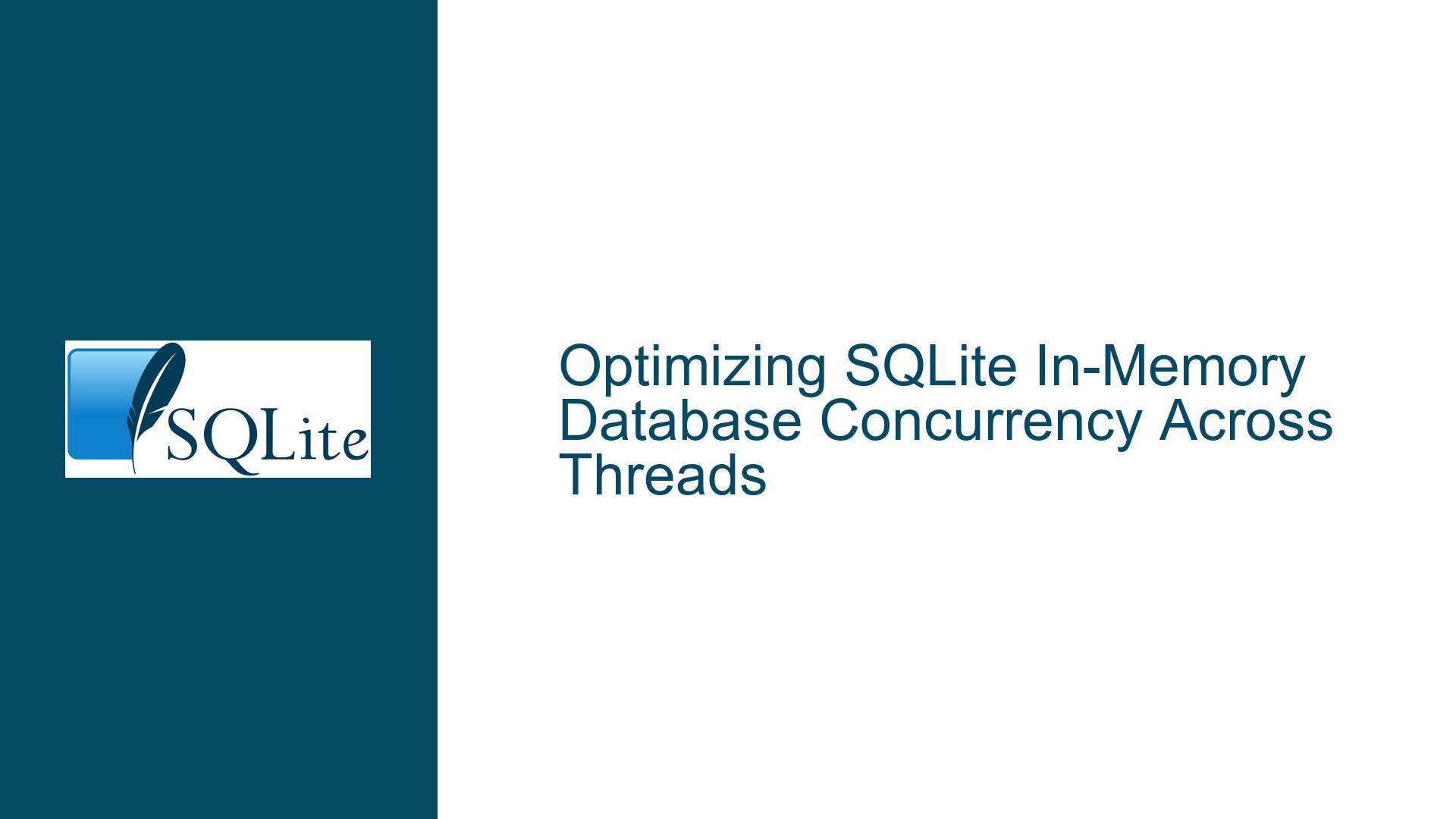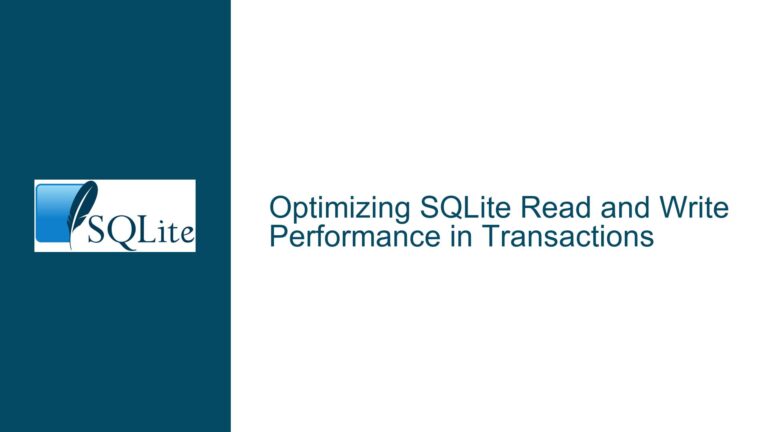Optimizing SQLite In-Memory Database Concurrency Across Threads
Understanding Performance Bottlenecks in Multi-Threaded SQLite In-Memory Databases
Issue Overview: Serialized Performance Despite Independent Databases
A developer attempted to achieve high concurrency on a many-core machine by assigning each thread its own independent in-memory SQLite database. This approach aligns with scenarios requiring data sharding across threads (e.g., parallel batch processing or isolated session management). The expectation was that thread-local databases would eliminate contention, allowing linear scalability with CPU cores.
However, benchmark results showed no performance improvement compared to serialized access—even when using named in-memory databases (file::memory:?cache=shared), :memory: URIs, or compile-time single-thread mode. Tests included variations of connection flags like SQLITE_OPEN_NOMUTEX (non-serialized mode) and SQLITE_OPEN_PRIVATECACHE (isolated page cache), but none resolved the bottleneck.
Key observations:
- Thread-local databases (no shared data) should theoretically avoid locks.
- Hardware utilization remained suboptimal (e.g., CPU usage plateauing at 20-30% on a 32-core system).
- Compile-time adjustments (disabling pthreads, single-thread mode) had no effect.
This suggests a systemic limitation within SQLite’s runtime configuration or memory management layer.
Root Causes: Memory Allocation Serialization and Thread Safety Misconfigurations
1. SQLITE_DEFAULT_MEMSTATUS and Memory Tracking Overhead
SQLite tracks memory usage statistics by default via sqlite3_status() APIs. Enabling this feature (SQLITE_DEFAULT_MEMSTATUS=1) wraps memory allocation calls in a global mutex to ensure thread-safe updates to internal counters. This serializes all heap operations—even for unrelated databases—across threads.
Impact:
- Contention on the memory allocator becomes the hidden bottleneck.
- False scalability ceiling arises despite independent databases.
2. Threading Mode Mismatches
SQLite supports three threading modes:
| Mode | Description | Use Case |
|---|---|---|
| Single-thread | No mutexes; unsafe for concurrency | Embedded systems |
| Multi-thread | Connections isolated to threads | High-read workloads |
| Serialized | Full mutex protection (default) | General-purpose |
If compiled with SQLITE_THREADSAFE=2 (multi-thread mode) but connections lack SQLITE_OPEN_NOMUTEX, internal locks serialize operations.
3. Connection Flag Misuse
SQLITE_OPEN_PRIVATECACHE: Isolates page cache but doesn’t disable memory stats.SQLITE_OPEN_EXCLUSIVE: Prevents other connections from opening the DB—irrelevant for:memory:.
4. Fileless Backend Limitations
In-memory databases bypass disk I/O but still rely on SQLite’s global memory allocator. Unlike file-backed databases (which use memory-mapped I/O), :memory: databases cannot leverage OS-specific optimizations for concurrent heap access.
Resolving Contention: Reconfiguration and Compile-Time Optimizations
Step 1: Disable Memory Statistics Tracking
Recompile SQLite with SQLITE_DEFAULT_MEMSTATUS=0 to eliminate mutexes around sqlite3_malloc():
# Download amalgamation source
curl -O https://sqlite.org/2025/sqlite-amalgamation-3450000.zip
unzip sqlite-amalgamation-3450000.zip
cd sqlite-amalgamation-3450000
# Compile with optimized flags
gcc -DSQLITE_DEFAULT_MEMSTATUS=0 -DSQLITE_THREADSAFE=2 -lpthread -O3 \
shell.c sqlite3.c -o sqlite3
Verification:
sqlite> PRAGMA compile_options;
...
SQLITE_DEFAULT_MEMSTATUS=0
SQLITE_THREADSAFE=2
Step 2: Enforce Thread-Local Memory Pools
Override the default allocator with a thread-aware alternative:
// Custom allocator using thread-local arenas
void *thread_local_malloc(int size) {
static __thread void *pool = NULL;
if (!pool) pool = malloc(16 * 1024 * 1024); // 16MB per thread
// Implement arena-based allocation...
}
sqlite3_mem_methods custom_methods = {
.xMalloc = thread_local_malloc,
.xFree = thread_local_free,
// ... other methods
};
sqlite3_config(SQLITE_CONFIG_MALLOC, &custom_methods);
This bypasses global heap contention entirely.
Step 3: Validate Threading Mode at Runtime
Ensure connections open with SQLITE_OPEN_NOMUTEX in multi-thread mode:
# Python example using apsw
import apsw
conn = apsw.Connection(":memory:", flags=apsw.SQLITE_OPEN_NOMUTEX)
Step 4: Profile Memory Contention
Use perf or dtrace to identify lock contention:
perf record -e lock:contention -g ./my_app
perf report
Look for pthread_mutex_lock calls originating from sqlite3Malloc.
Step 5: Alternative Sharding Strategies
If contention persists:
- Database-per-thread with file-backed storage:
sprintf(db_path, "file:/tmp/db_thread%d?mode=memory&cache=shared", thread_id); sqlite3_open_v2(db_path, &db, SQLITE_OPEN_URI | SQLITE_OPEN_READWRITE, NULL); - In-process sharding with
ATTACH DATABASE:ATTACH ':memory:' AS shard1; USE shard1;
Step 6: Evaluate Alternative Allocators
Replace the system allocator with jemalloc or tcmalloc for better concurrency:
LD_PRELOAD=/usr/lib/x86_64-linux-gnu/libjemalloc.so.2 ./my_app
Conclusion: Balancing Concurrency and Memory Safety
SQLite’s in-memory databases can achieve near-linear scalability across threads when configured correctly. The primary adversary is not SQLite itself but default settings prioritizing memory safety over raw throughput. By disabling memory statistics, selecting appropriate threading modes, and leveraging thread-local allocators, developers unlock the full potential of multi-core systems. Always validate configurations through low-level profiling to isolate contention points invisible at the ORM or query layer.






